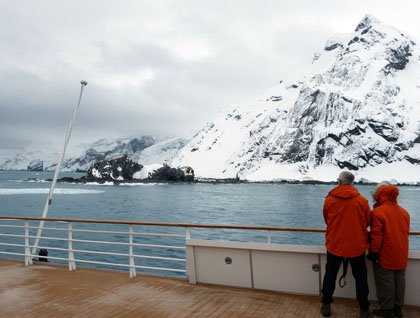Point Wild, Elephant Island: a good place to spend an expedition morning in the early Antarctic summer, but four months, through an Antarctic winter??! Maybe not, but the men of Ernest Shackleton's ship Endurance had no choice.
April 16, 1916: The three lifeboats from Endurance, newly named after the expedition's main sponsors James B. Caird, Dudley Docker, and Stancomb Wills, landed at Cape Valentine, the eastern extreme of Elephant Island. For the first time in 16 months, 28 pairs of feet, not all of them in good shape (the stowaway, Perce Blackborrow, with frozen toes), stood on terra firma. But it was immediately evident to Shackleton and his lieutenant, Frank Wild, that this spot would provide them no refuge at high tide. They must find better, so Shackleton sent Wild off to search. What he found was the place we now call Point Wild, seven miles from Cape Valentine. It is a tiny, rocky spit of land sticking out from the sheer face of Elephant Island. I can well imagine the men of Endurance thinking, if not uttering, "Frankie—is this the best you could do?" But there, sleeping under the two remaining lifeboats, twenty-two men waited for four cold, hungry months. If The Boss succeeded in his audacious plan to sail the James B. Caird across the most tumultuous of the world's oceans to South Georgia Island, they might be saved. If The Boss failed, there would be no rescue. They could only survive day-to-day while they waited and hoped. Each morning Frank Wild would wake them with the call "Lash and stow, boys. The Boss may be coming today."
This morning we completed our passage from South Georgia to Elephant Island. At Point Wild we boarded our Zodiacs to match the sights now before us with the historic images recorded by the expedition photographer, Frank Hurley on his 1914-vintage Kodak pocket camera. There, before us, was the beach where the Caird was launched and provisioned with two casks of water, a primus stove, powdered milk and pemmican to boil into a soup-like “hoosh." And there were the glaciers that enclose the site. Their rumblings and calving of ice into the bay struck fear into the hearts of the stranded sailors. Chinstrap penguins were standing in clusters on the snow, waiting for it to leave the site so they could lay their two eggs on beds of pebbles. Cameras clicked in burst mode; Hurley, in contrast, had only three rolls of film to expose. He must have wondered if the world would ever see the subjects of his precious exposures. Thank goodness; The Boss succeeded, and Hurley, his exposures, and his comrades all survived to tell the tale of Endurance.
Following Shackleton's route in reverse, we sailed to Cape Valentine. There we found a group of three humpback whales to add to our total of cetacean species. The last two days have been rich in whales. They seem to be recovering from the very low abundance to which they were driven by whalers in the early decades of the 20th century.
[Note: our guests have asked that I not report on our weather and the current sea state, lest it jinx us and change our good fortune.]







